History in the making
The completion of the Sir William Henry Bragg Building marks a defining moment in the University’s mission to address 21st century challenges.
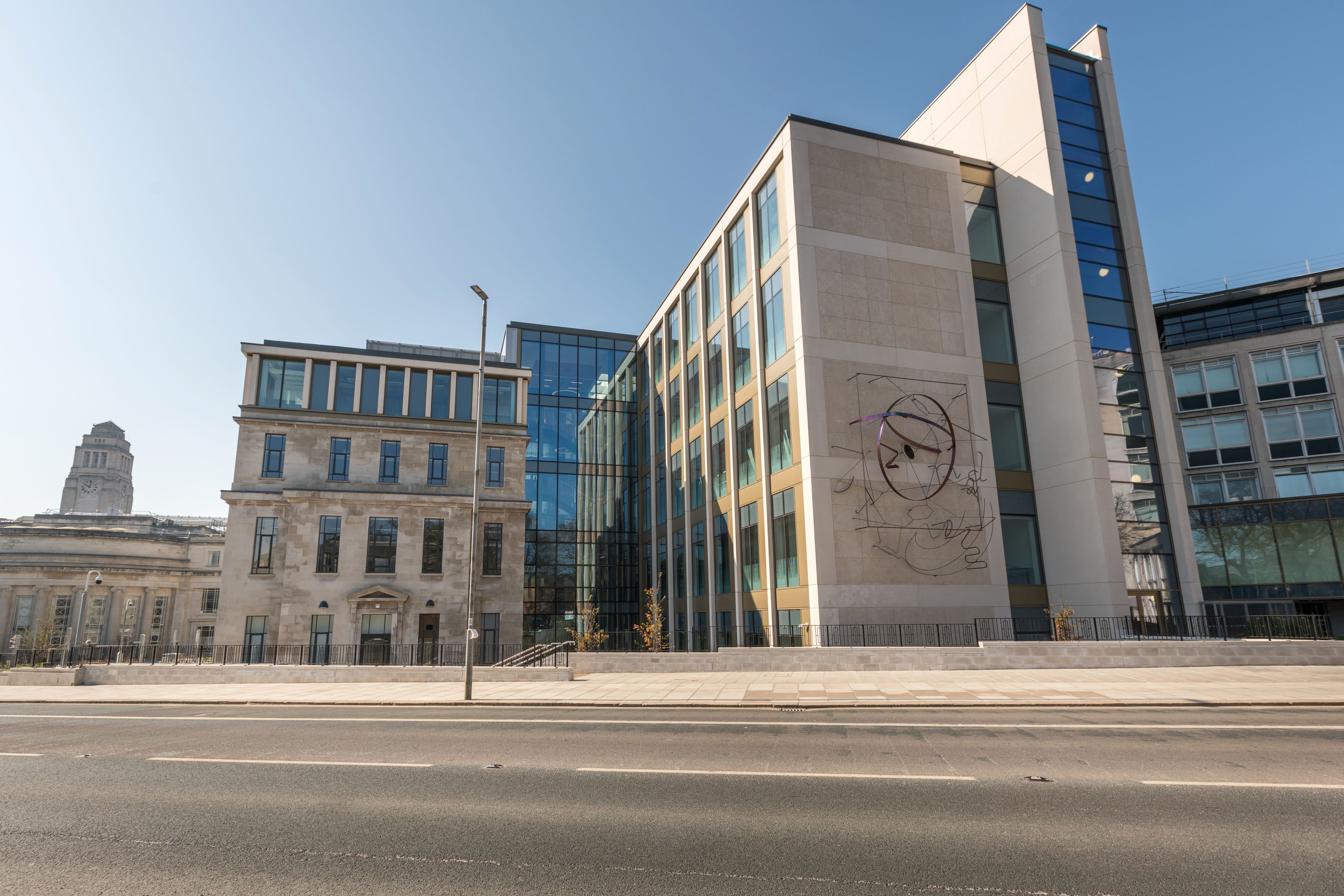
The stunning new building brings together the School of Physics and Astronomy, the School of Computing and the Bragg Centre for Materials Research to create an engineering and physical sciences hub. First-class laboratories and specialised teaching spaces will foster world-leading research and an outstanding student experience – but its capacity for inter-disciplinary working and collaboration with industry breaks traditional boundaries to have a positive impact for all society.
As researchers, students and industry experts walk through the doors of the £96 million building on Woodhouse Lane, they are greeted by a bust of Sir William Henry Bragg and his Nobel medal. The building is a fitting tribute both to William, Professor of Physics from 1909 to 1915, and to his son Lawrence. To this day, their work has many applications – from drug development to computing, medicine to astronomy.
In a Leeds workshop, William and Lawrence built the first X-ray spectrometer which was used to measure the way X-rays scattered. By directing them through matter and recording the resulting diffraction pattern on photographic plates, the pair determined the atomic structure of crystallised materials. Ever since, X-ray crystallography has been used throughout the world to reveal the structure of molecules fundamental to life.
“The father and son team embodied everything that is good about science,” says Professor Nora de Leeuw, Executive Dean for the Faculty of Engineering and Physical Sciences. “They were curious, creative and prepared to think beyond traditional subject boundaries. The building that takes the name of Sir William Henry Bragg will continue to foster that philosophy.”
Work began in May 2017 with the clearance of an office building, plumbing and locksmith workshops and an old boiler house. The Portland stone façade of the Grade II listed Old Mining Building, built in 1930, was retained and incorporated into the design, blending the past with the present. Behind it, a walkway connects a new seven-storey glass-and-steel complex with teaching rooms and laboratories designed to meet the rigours of 21st century science.
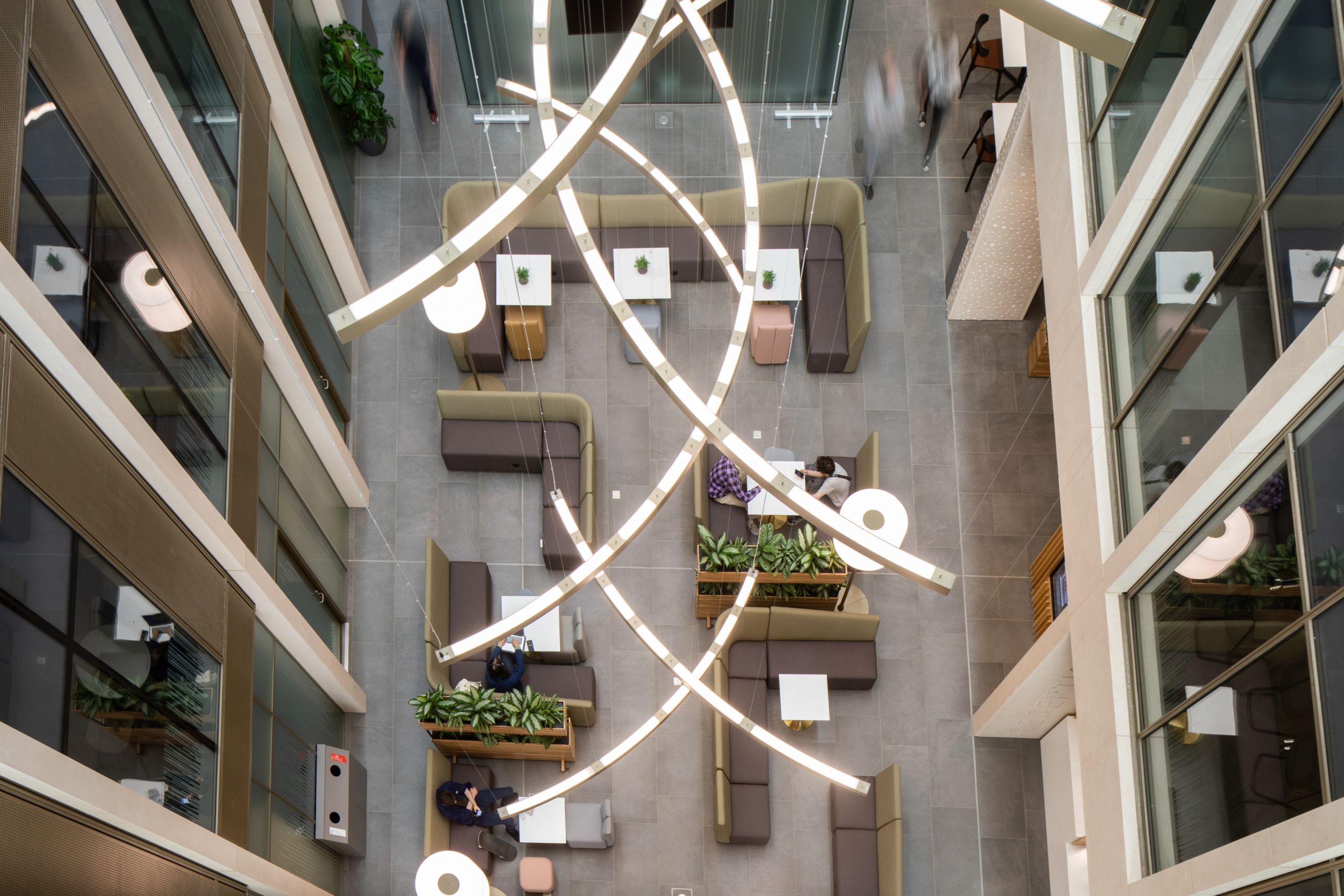
The light-filled atrium provides social breakout and collaboration space
The light-filled atrium provides social breakout and collaboration space
“The building houses some of the most advanced research facilities in the country,” says Nora. Take for example the 3,000m2 basement, dug into the bedrock to ensure the vibration of passing traffic does not interfere with ultra-sensitive instruments. Individual quiet islands – raised platforms fitted with vibration-cancelling systems – reduce interference still further.
The laboratories provide the highest specification research environment: temperature and humidity can be monitored and adjusted; electromagnetic interference is controlled; air is filtered through a high-efficiency particulate-absorbing system; yellow light laboratories are provided for bionanotechnology and soft matter physics materials; clean room facilities ensure the eradication of contaminants. Just as the Braggs left their legacy upon the world, such a sophisticated facility is an investment in the University’s research capability for years to come.
In a similar vein, the state-of-the-art teaching spaces provide the perfect setting to develop the next generation of scientists. Digital technologies and audio-visual facilities offer opportunities for blended learning and knowledge sharing around the globe.
Sir William Henry Bragg’s work has shaped modern science. And it is my firm belief that the research conducted in the building that takes his name will extend that legacy.
At the heart of the design is an ethos of breaking down traditional boundaries. In robotics, for example, the new space will allow computer science experts to work with colleagues from electronic, electrical and mechanical engineering. It’s a theme reflected in a new sculpture by artist Sara Barker, gracing the exterior and entitled ‘The Worlds of If ’ – a reference to the possibilities unlocked when experts share ideas. Inside, the bright atrium, café and social areas provide a hub for interaction between academics from a variety of fields, and with industry partners.
“Experience tells us that the big questions in science will only be tackled when researchers from different disciplines collaborate on solving problems,” says Nora. “The building is a place for people to do that, bringing together scientists – and often artists – in the quest for new understanding and insight.
“Sir William Henry Bragg’s work has shaped modern science. And it is my firm belief that the research conducted in the building that takes his name will extend that legacy.”
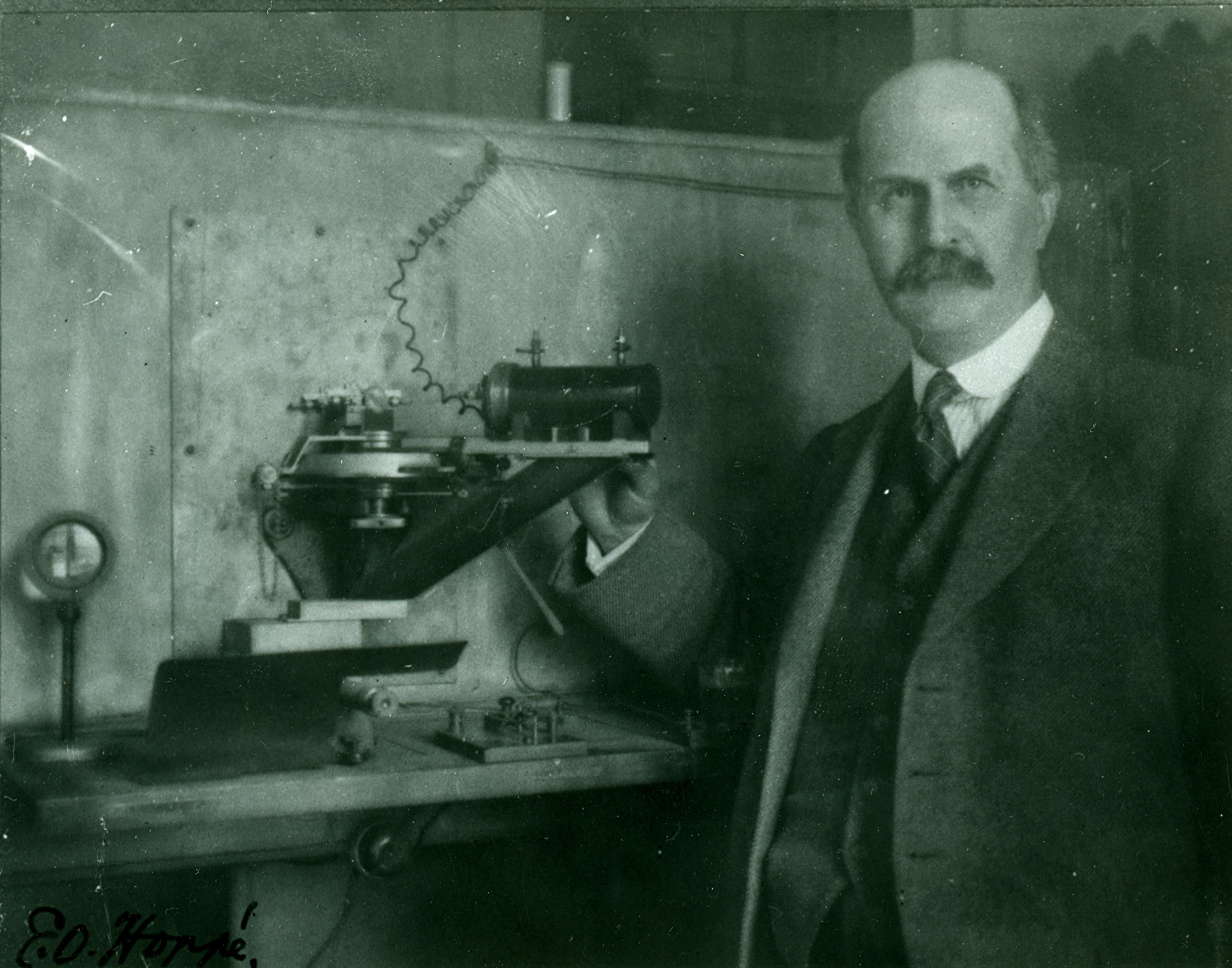
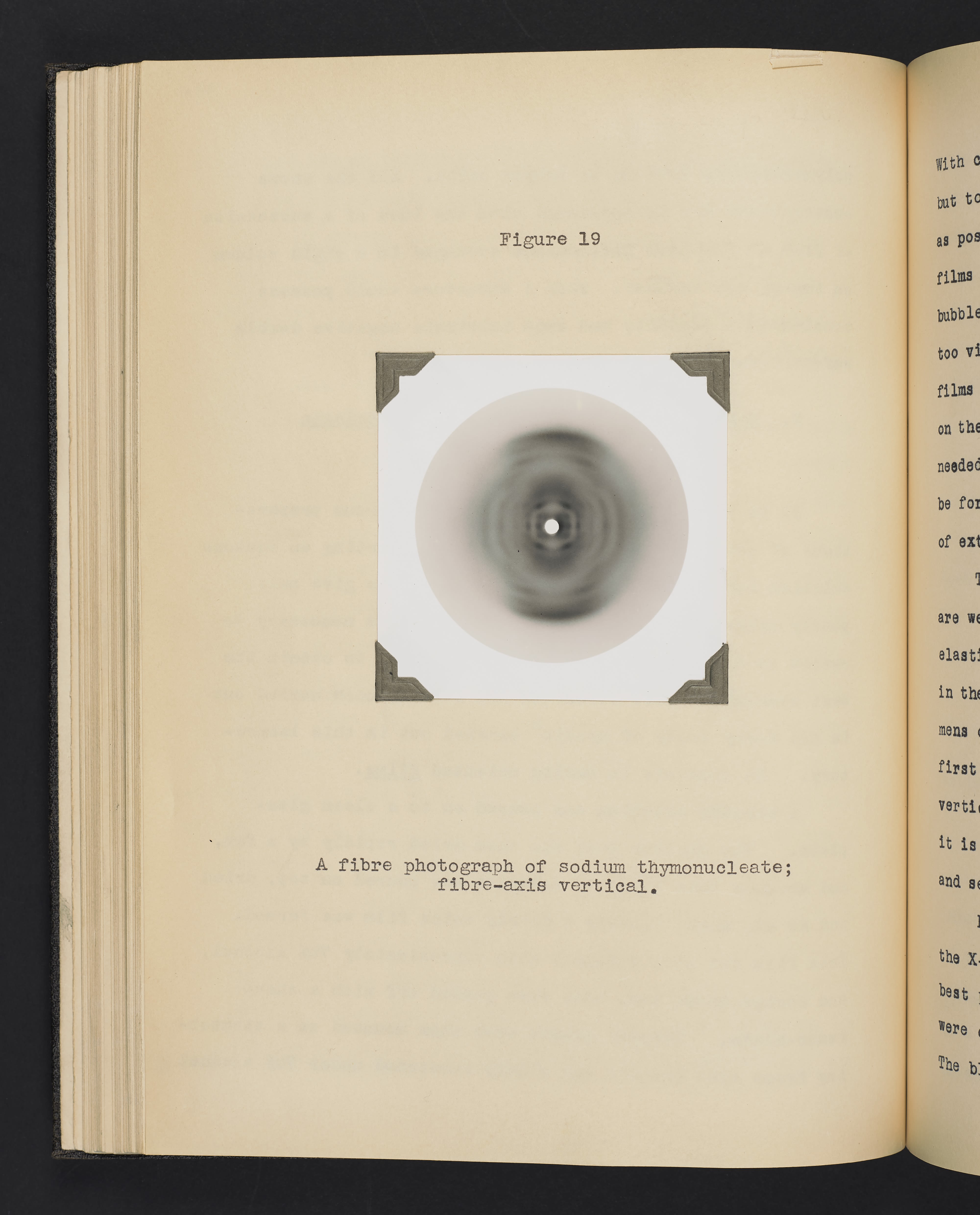
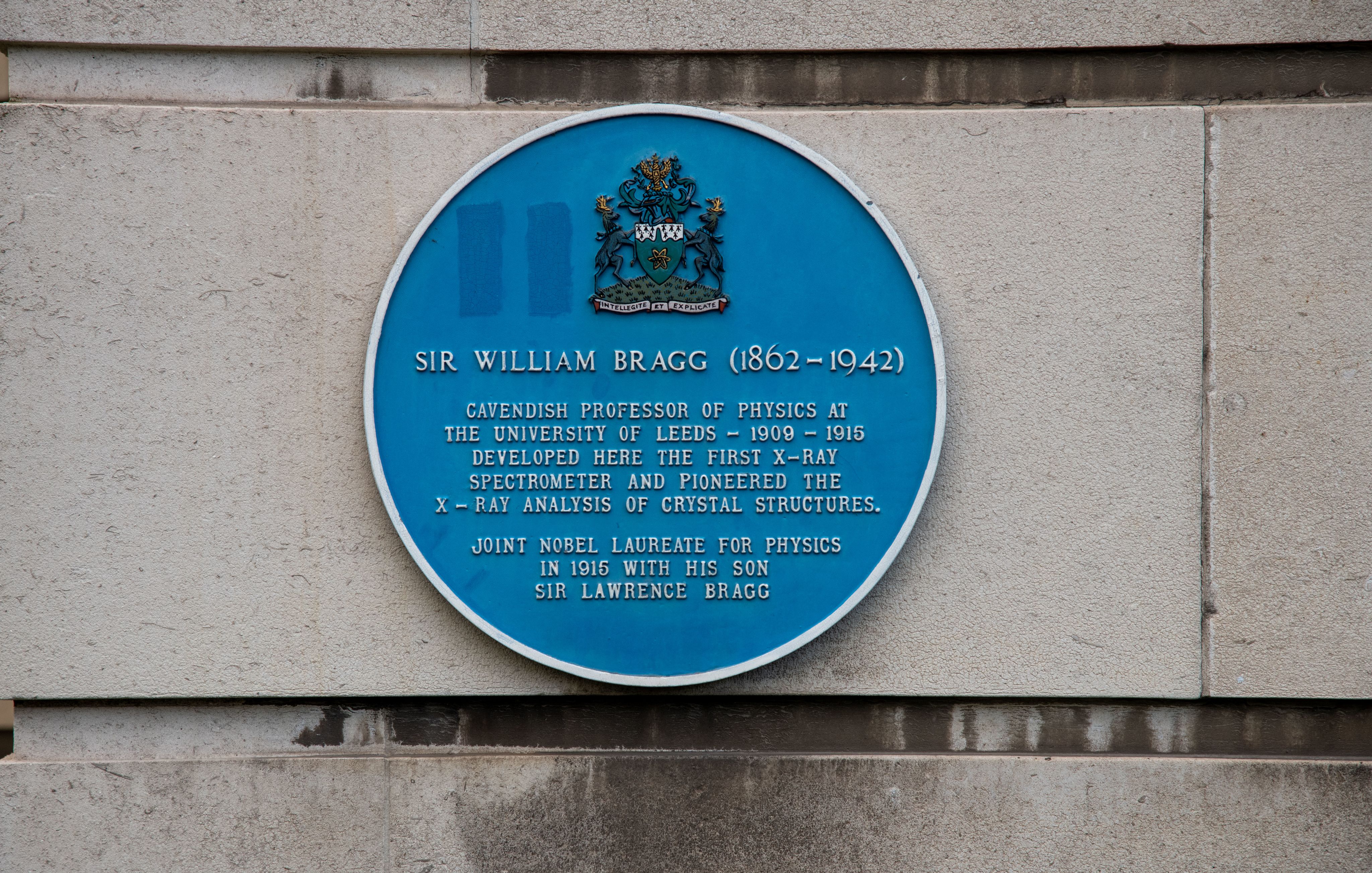

Image courtesy of the Royal Institution Archive: William is pictured in 1922 with the spectrometer that he and Lawrence built to allow them to understand crystal structures, making it possible to develop new and better materials.
Image courtesy of the Royal Institution Archive: William is pictured in 1922 with the spectrometer that he and Lawrence built to allow them to understand crystal structures, making it possible to develop new and better materials.

Special Collections, University of Leeds: PhD student Florence Bell used X-ray crystallography to take some of the earliest photographs of the structure of DNA while at Leeds, including the one above. In a paper published in Nature, she described the structure as “a pile of pennies”.
Special Collections, University of Leeds: PhD student Florence Bell used X-ray crystallography to take some of the earliest photographs of the structure of DNA while at Leeds, including the one above. In a paper published in Nature, she described the structure as “a pile of pennies”.

A blue plaque on the Parkinson Building celebrates the Braggs. In 2013, an online vote of 80,000 people named their work as the third most important British innovation of the 20th century.
A blue plaque on the Parkinson Building celebrates the Braggs. In 2013, an online vote of 80,000 people named their work as the third most important British innovation of the 20th century.
Three areas of the Sir William Henry Bragg Building showcase the power of collaboration between Leeds researchers and industry to tackle societal challenges.
Bragg Centre for Materials Research
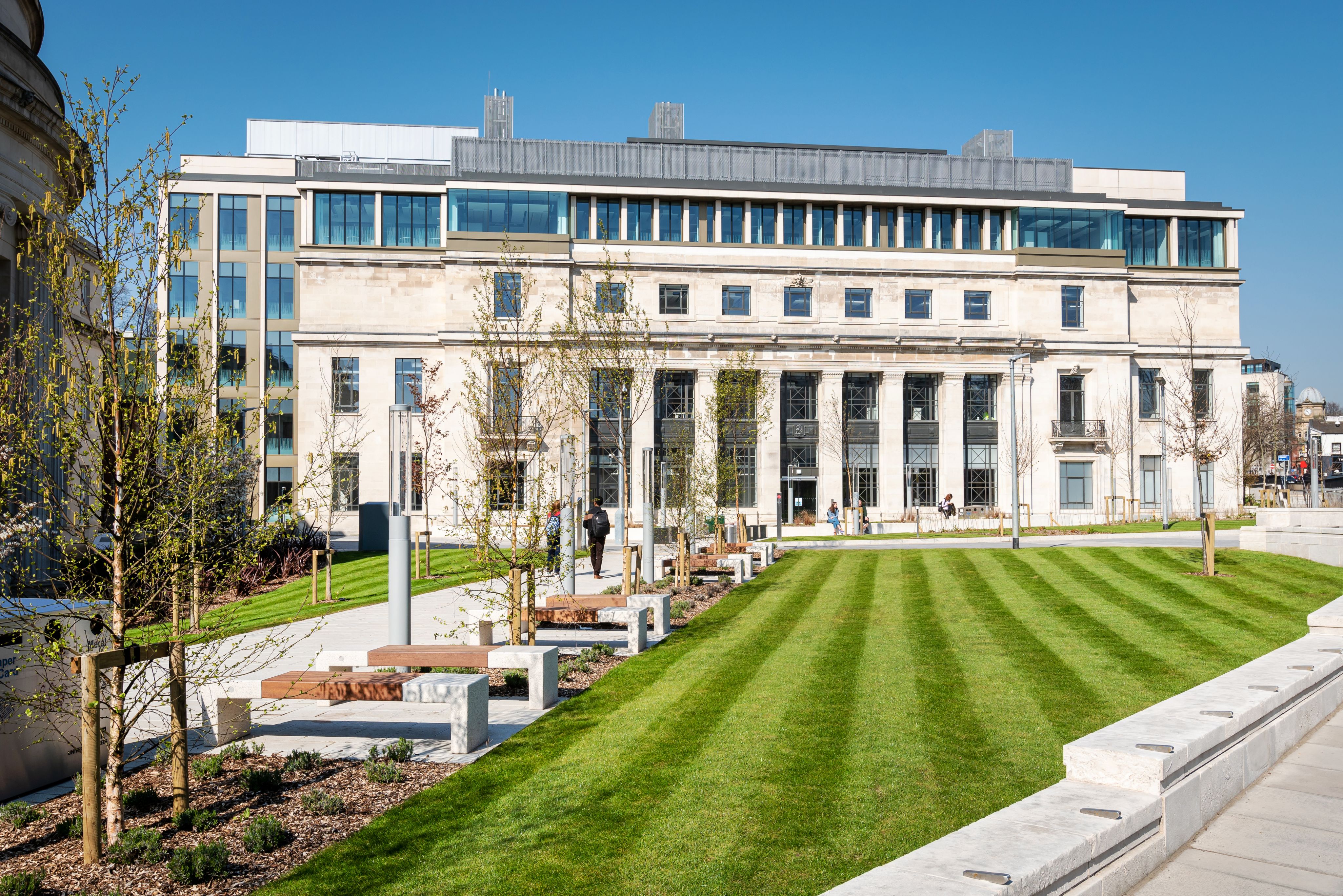
It is fitting for a city steeped in textiles history that Leeds is world leading in materials research.
Founded in 2019, the Bragg Centre for Materials Research provides cutting-edge facilities for a creative community of 250 members from across engineering and physical sciences, biology, medicine, and the arts who aim to discover, create and design new materials that address fundamental scientific and global challenges. Now, with the new building providing a focal point for their work, the impact will only grow.
“The outstanding facilities in the Bragg Building will allow us to engineer materials at the atomic and molecular scale, and undertake internationally leading science and engineering,” explains Professor Edmund Linfield, Director of the Bragg Centre for Materials Research.
Take for example the FIBSEM-SIMS facility, which allows for 3D nanoscale chemical analysis. This will fill a pivotal imaging gap for the analysis of important, hybrid materials used in a wide range of medical, chemical, structural and electronic applications.
It is such real-world applications that are so important: “The new building helps us to bring together people across campus alongside external professionals to find out what their needs are and help to meet them,” Edmund explains. “It means we can respond to real societal, economic and technical challenges.”
The potential of these facilities to attract the very best international researchers and support to Leeds is extremely exciting.
One of the challenges already being investigated at Leeds is the transition to a net-zero-carbon-emitting economy. Working with the Henry Royce Institute – the UK’s national institute for advanced materials of which Leeds is a founding partner – a road-mapping exercise has identified the critical role new materials and processes can play in delivering energy-efficient electronics. By developing semiconducting, superconducting and magnetic materials, researchers are making these energy-efficient devices a reality.
Collaborating with the Leeds Teaching Hospitals NHS Trust, world-leading bionanotechnology research will directly impact healthcare. For example, the development of organ-on-a-chip systems – chips lined with living human cells and fluidic channels to recreate conditions in the body – will allow researchers to test the impact of drug treatments, leading to more effective drug development. Smart and responsive materials developed in the building will be used in stem cell therapies and targeted drug delivery.
The Bragg Centre’s cross-departmental collaboration is so aligned to the Bragg building’s ethos that Edmund can only see it flourishing in its new home: “We will be able to strengthen our interdisciplinary research partnerships and deliver sustainable solutions to global challenges. The potential of these facilities to attract the very best international researchers and support to Leeds is extremely exciting.”
Wolfson Imaging Facility
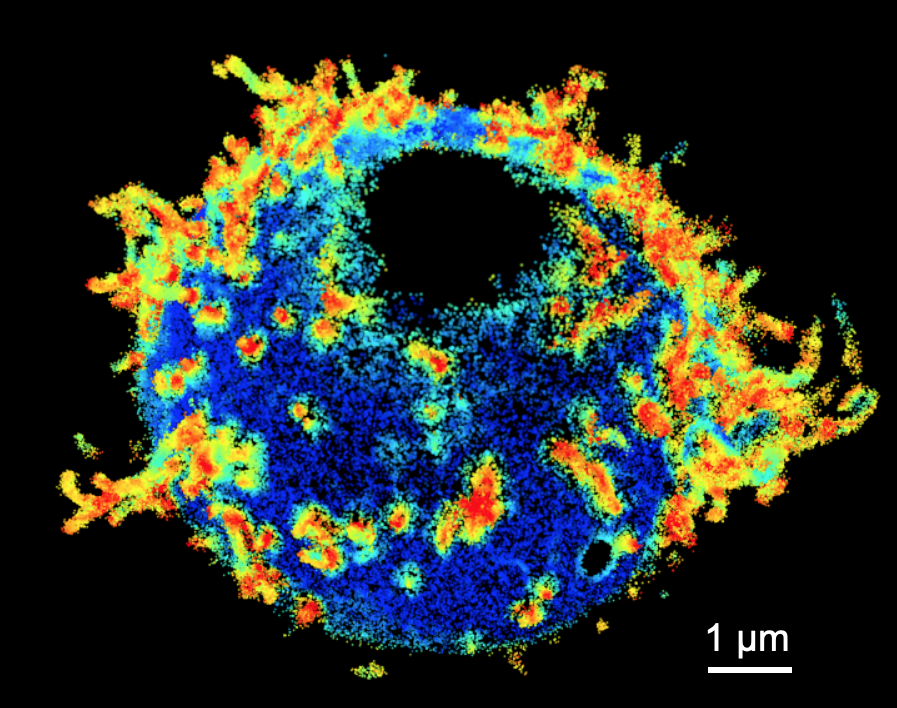
The basement of the Bragg Building will house the Wolfson Imaging Facility. Supported by a £750,000 donation from the Wolfson Foundation and a further gift from Dr Chris Pointon (Chemistry and Earth Sciences 1970), its instrumentation is enabling scientists to see molecules interacting in real time – more rapidly and accurately than ever before.
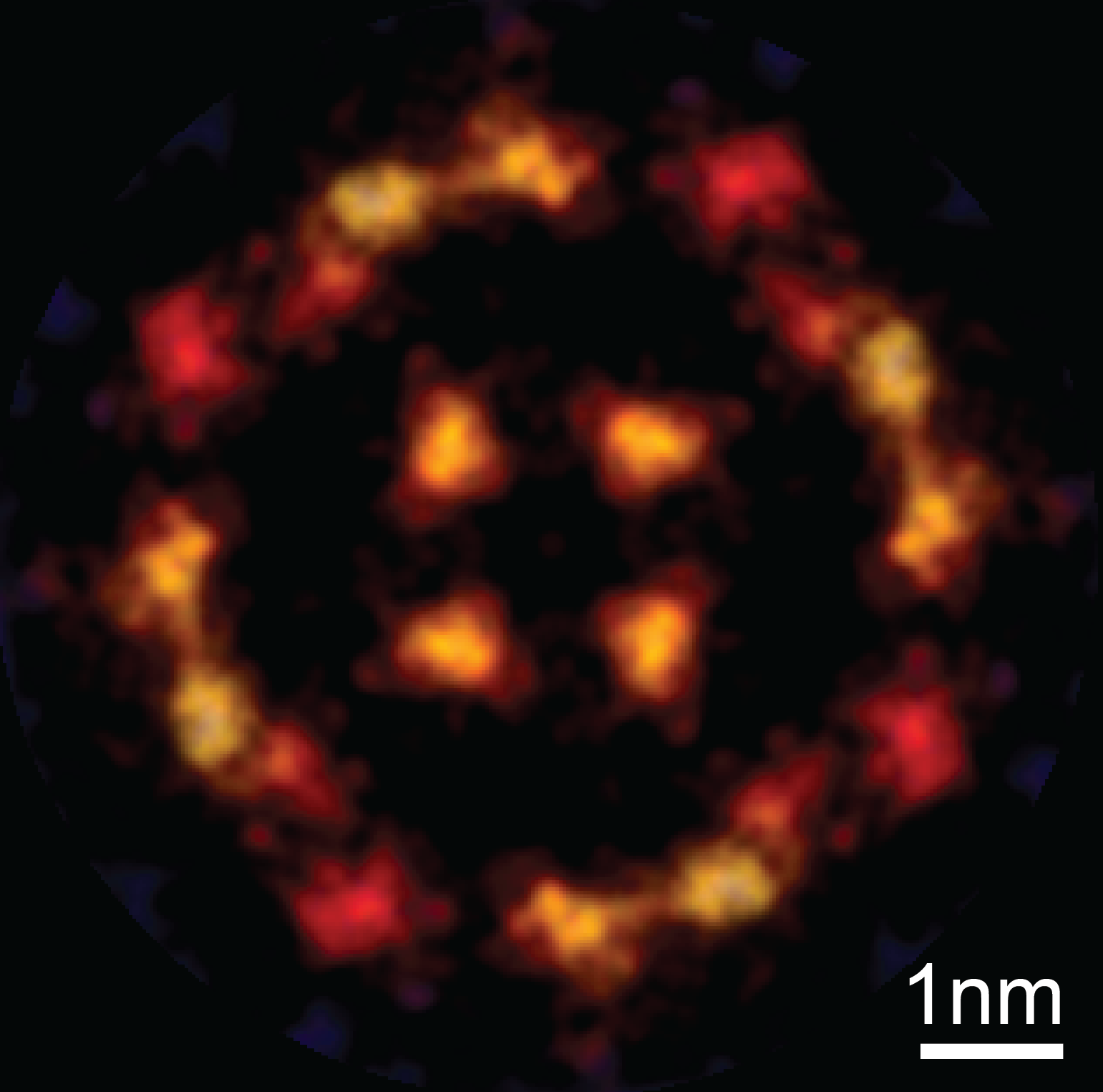
Localization atomic force microscopy shows the surface structure of a bacterial aquaporin membrane protein
Localization atomic force microscopy shows the surface structure of a bacterial aquaporin membrane protein
“Currently, methods to study molecules in atomic detail typically involve a static snapshot,” says Dr George Heath, Academic Fellow in the School of Physics and Astronomy. “But a new generation of high-speed atomic force microscopes can capture data very rapidly, almost every millionth of a second. The collection of data is so fast, we can generate videos of molecules in action. This is a very exciting news for UK science.”
Super-resolution fluorescence techniques can be used to see fine details down to the scale of 20nm (a nanometre is one billionth of a metre), and fluorescent dyes and lasers are used to highlight the target molecules and see molecular motion across an entire cell in real time.
By making our facilities available to scientists around the world, new discoveries and expertise can be rapidly shared so that the entire community can benefit from this investment.
The implications are cross-disciplinary, and the £3.5 million investment brings together two research centres at Leeds: Astbury Centre for Structural Molecular Biology, which investigates the molecular basis of life, and the Bragg Centre for Materials Research.
In medicine, the ability to see how a particular molecule behaves in a cell, interacting with neighbouring structures, will give important indicators of whether a cell is healthy or a disease process is starting. Researchers will be able to watch how viruses attack cells, how immune cells get ready to attack their targets, and how potential new drugs interact with molecules.
Professor Sheena Radford FRS, joint lead on the Wolfson project, said: “We will make the facility available to all scientists with exciting questions to answer from across the UK and even further afield. In that way, new discoveries and expertise can be rapidly shared so that the entire community can benefit from this investment.”
Support Leeds research
Find out more about how you can help support ground-breaking research at Leeds.
Your gifts enable us to nurture talent, raise aspirations and power societal change.
Each one of our worldwide community of supporters plays a vital role in supporting our University’s outstanding research and education.
With your help, we can shape a better future for humanity.
Life-saving robotics
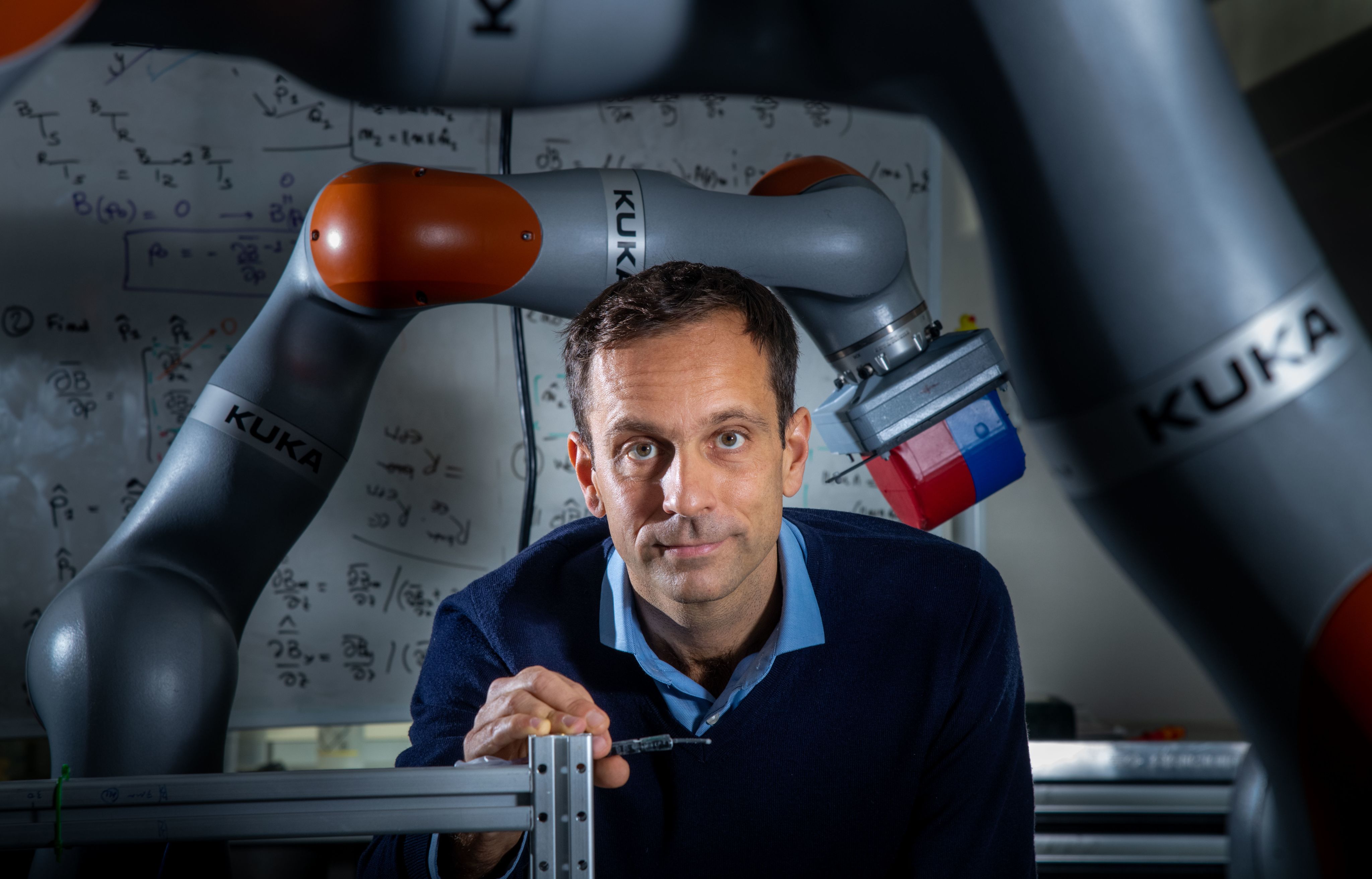
Access to a 150m2 mock medical operating theatre will allow the Robotics at Leeds research group to develop life-saving robotic systems for medicine and healthcare.
The Leeds Science and Technologies of Robotics in Medicine (STORM) Lab strives to enable earlier diagnosis, wider screening and more effective treatment for disease, and is led by Professor Pietro Valdastri.
There are many potential benefits to their work. Surgical robots amplify the perceptual and manipulation capabilities of surgeons, giving them added precision and dexterity. Increasing the distance between surgeon and patient can reduce the risk of disease transmission, an issue brought into sharp focus by the Covid-19 pandemic. But the translation of a successful prototype to human trials has sometimes proved an obstacle in realising the potential of such technology – they are often too impractical to be integrated into an operating room.
A mock operating theatre, which a gift from the Garfield Weston Foundation will move forward, allows researchers and clinicians to address this challenge together. Leeds researchers will be able to co-design solutions with clinicians, healthcare providers and patients; they’ll ensure the equipment is effective in hospital settings by simulating the clinical workflow; they’ll train surgeons in using the new tools. Feedback during early stages can accelerate the lab-to-patient development of life-saving technologies.
“Having access to a realistic clinical environment will allow researchers to evaluate how clinical staff interact with robotic platforms,” Pietro says. “This will help us get our ideas and inventions working in the real world much more quickly.”
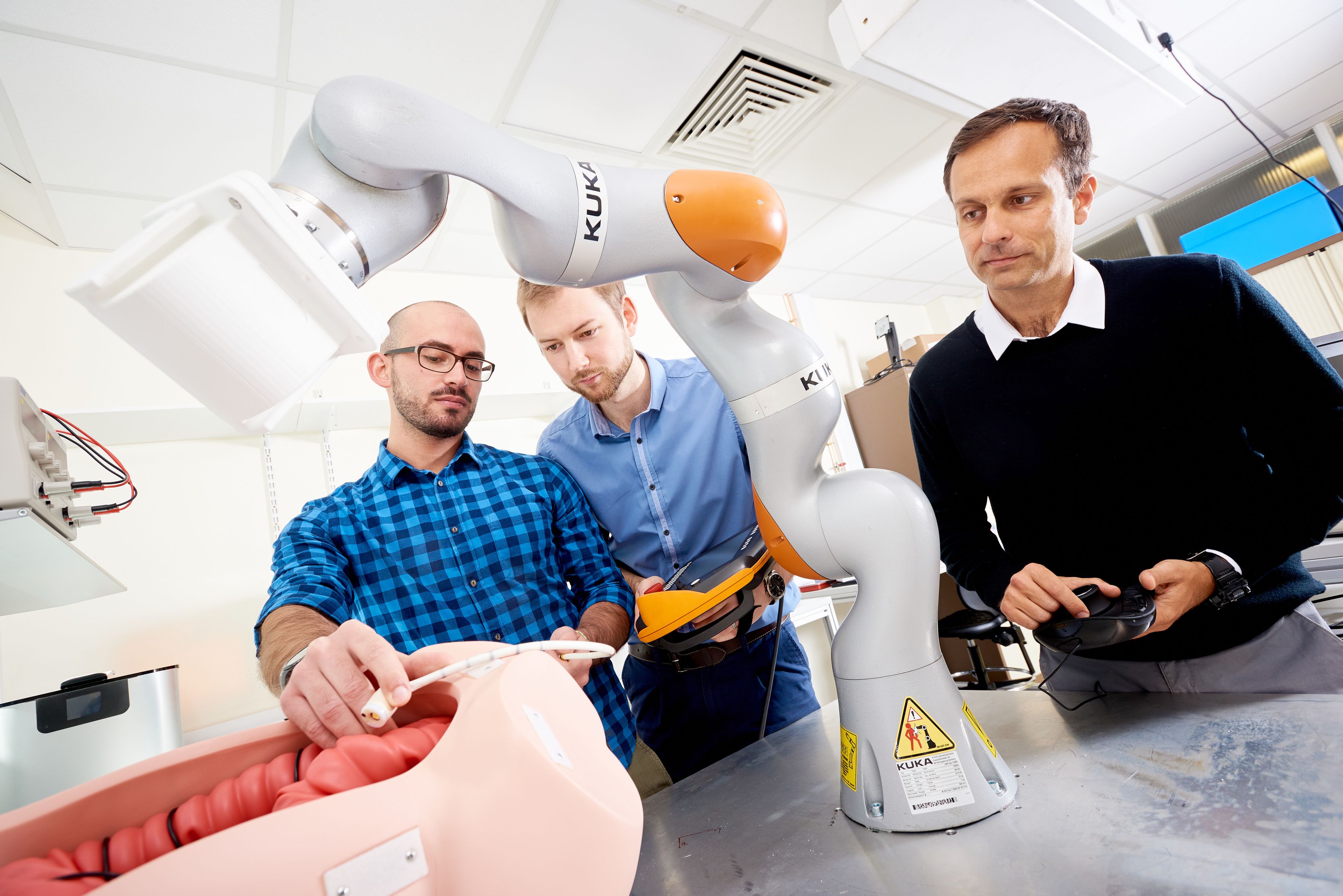
Robotic colonoscopy equipment combines robotics with magnetic manipulation to guide the endoscope
Robotic colonoscopy equipment combines robotics with magnetic manipulation to guide the endoscope
At Leeds, those technologies include robotic colonoscopy for colorectal cancer screening and surveillance, which combines robotics and magnetic manipulation to gently guide a flexible endoscope through the colon, replacing the painful ‘push’ mechanism of traditional approaches and removing the need for anaesthesia. The team is also developing magnetic tentacle robots to deliver image-guided therapies and personalised treatment in lung, pancreatic and deep-brain cancer.
In short, robotic technologies developed in the Bragg Building could help ensure the earlier detection of cancer, create effective new treatments – and save lives.
What did you think?
Alumni can learn more by exploring Inspired by Bragg, a project bringing together minds and ideas from across the University of Leeds and beyond to celebrate Sir William Henry Bragg - a former professor at Leeds who was jointly awarded the Nobel Prize for Physics in 1915.
